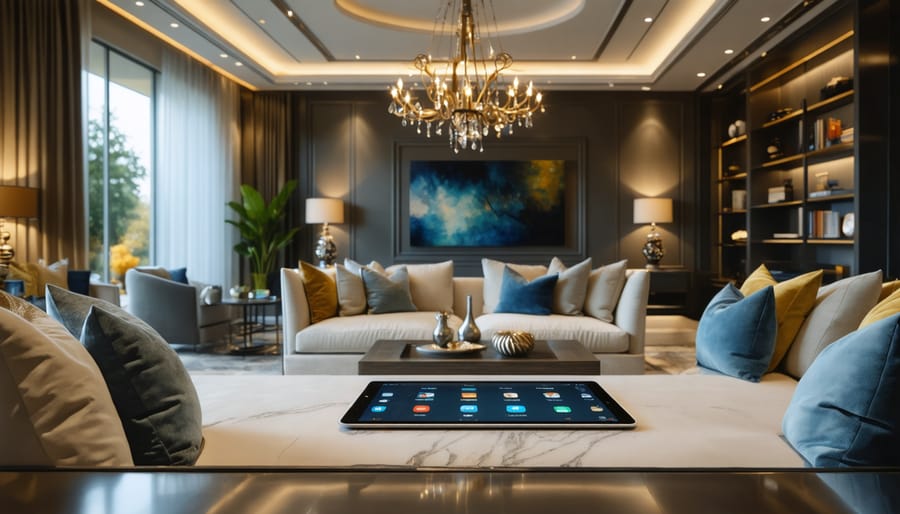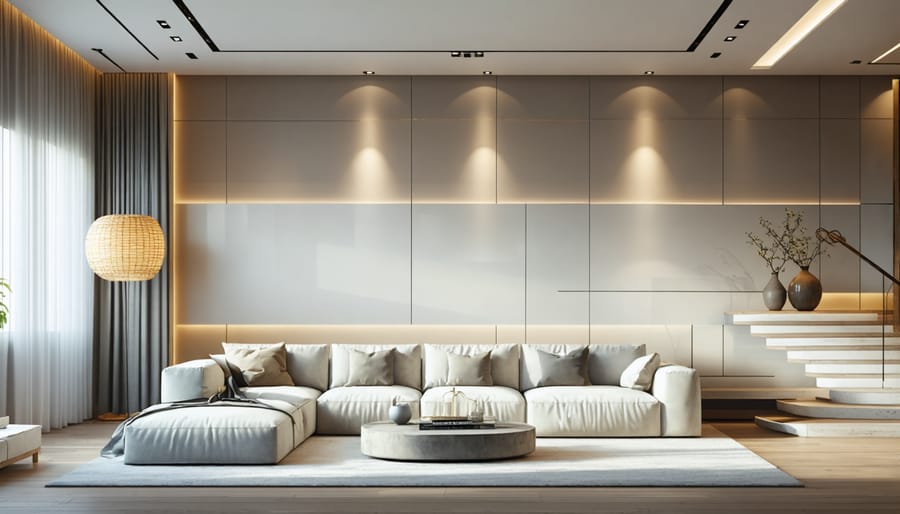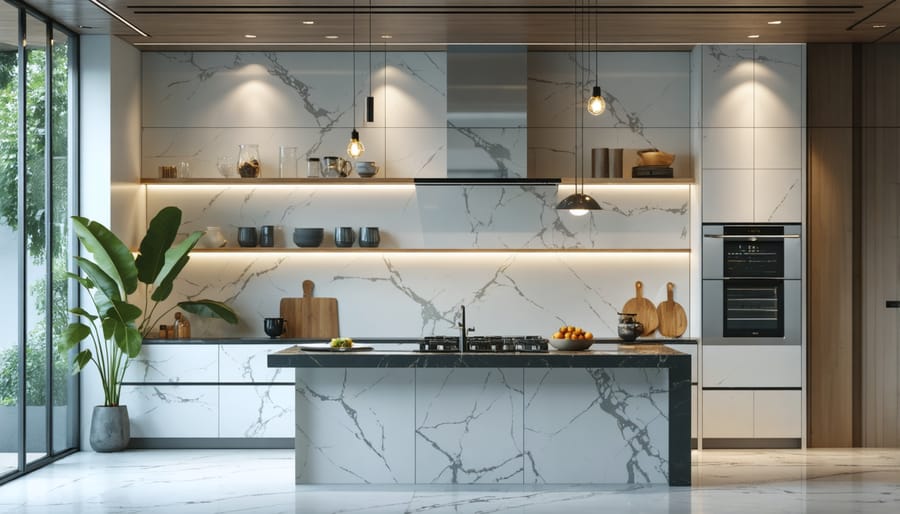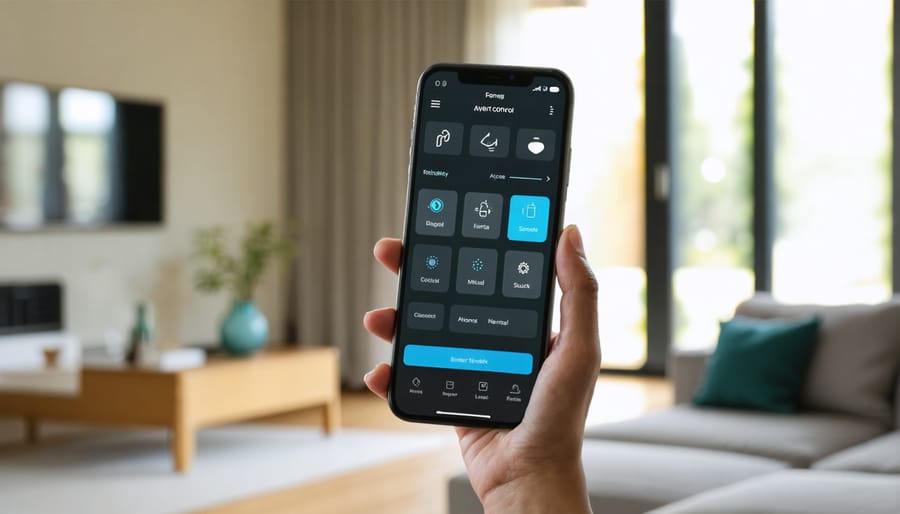
Transform Your Home’s Ambiance with Smart Lighting Design
Transform your home’s atmosphere by mastering the three fundamental layers of lighting: ambient, task, and accent illumination. Start with a comprehensive lighting plan that maps out daily activities in each room, identifying where you need bright task lighting for cooking or reading, and where softer ambient light creates warmth. Integrate creative lighting solutions like dimmable LED fixtures and smart controls to adjust brightness levels throughout the day, maximizing both functionality and energy efficiency. Position light sources at different heights—floor lamps, wall sconces, and ceiling fixtures—to eliminate harsh shadows and create visual interest while ensuring every corner serves its intended purpose. Modern lighting design balances form and function, turning everyday spaces into welcoming environments that enhance both your home’s aesthetic appeal and your quality of life.

The Three Layers of Home Lighting
Ambient Lighting: Setting the Foundation
Ambient lighting serves as the foundation of any well-designed home lighting scheme, providing the essential base layer of illumination that makes spaces functional and welcoming. Think of it as your room’s primary light source, working alongside natural lighting elements to create a comfortable atmosphere.
The key to successful ambient lighting lies in even distribution. Ceiling-mounted fixtures, such as flush mounts or chandeliers, should be positioned to provide consistent illumination throughout the space. For rooms with standard 8-foot ceilings, aim to space recessed lights approximately 8 to 10 feet apart, ensuring complete coverage without creating harsh shadows.
Consider using dimmers with your ambient lighting fixtures – they’re game-changers for controlling light levels throughout the day. Modern LED options offer excellent energy efficiency while providing warm, inviting light that rivals traditional incandescent bulbs. For larger spaces, layer your ambient lighting using a combination of ceiling fixtures and wall sconces to eliminate dark corners and create depth.
When selecting bulb brightness, a good rule of thumb is to provide 20 lumens per square foot for living spaces. This ensures adequate illumination for everyday activities while maintaining a comfortable environment that doesn’t feel overly bright or harsh.
Task Lighting: Function Meets Style
Task lighting is essential for areas where you perform specific activities, combining functionality with decorative appeal. In the kitchen, under-cabinet lighting illuminates countertops for safe food preparation, while pendant lights over islands create focused light for cooking and casual dining. Consider LED strip lights for their versatility and energy efficiency – they’re perfect for highlighting workspaces without creating shadows.
For home offices, adjust your desk lamp’s position to minimize screen glare and prevent eye strain. A combination of direct and indirect lighting works best, with an adjustable desk lamp complemented by ambient light from wall sconces or floor lamps. Look for fixtures with color temperature controls to maintain productivity throughout the day.
In craft rooms or workshops, multi-directional lighting helps eliminate shadows. Articulating arm lamps allow you to direct light exactly where needed, while LED panels provide consistent, shadow-free illumination across larger work surfaces. Don’t forget to include lighting inside storage areas – battery-operated puck lights in drawers or cabinets make finding supplies easier.
Reading nooks benefit from adjustable floor lamps positioned behind seating areas. Choose fixtures with dimming capabilities to adjust light levels based on natural light conditions and time of day. For bedside reading, wall-mounted swing arm lamps free up nightstand space while providing targeted illumination.
Remember to consider the color rendering index (CRI) of your task lighting – higher CRI values ensure colors appear true and natural, which is particularly important for detailed work.
Accent Lighting: Creating Visual Interest
Accent lighting adds drama and sophistication to your home by highlighting specific features and creating visual depth. Strategic placement of wall accent lighting can transform an ordinary room into a stunning space that showcases your home’s best features.
Start by identifying architectural elements worth highlighting, such as exposed beams, textured walls, or decorative moldings. LED strip lights and small spotlights work wonderfully for these applications. For artwork, consider adjustable picture lights or track lighting that can be aimed precisely at your pieces.
Uplighting is particularly effective for drawing attention to tall plants, sculptures, or architectural columns. Place small fixtures at the base, pointing upward to create dramatic shadows and depth. For bookcases and display cabinets, install small LED puck lights to illuminate cherished collections and create a warm, inviting ambiance.
Don’t forget about outdoor accent lighting opportunities. Use well lights to highlight interesting landscaping features or architectural details on your home’s exterior. Solar-powered accent lights offer an energy-efficient solution for garden paths and water features.
Remember to layer your accent lighting with other light sources and use dimmers to adjust the intensity based on different times of day or occasions. This flexibility allows you to create the perfect atmosphere while showcasing your home’s unique characteristics.
Room-by-Room Lighting Solutions
Living Room and Family Spaces
Living rooms and family spaces serve multiple purposes, from casual gatherings to movie nights, so your lighting needs to be just as versatile. Start with ambient lighting using a central fixture like a modern chandelier or multiple recessed lights controlled by dimmer switches. This creates a foundation of light that you can easily adjust for different activities.
Layer in task lighting with strategically placed floor lamps near reading nooks and table lamps beside seating areas. These provide focused illumination for activities like reading, crafting, or board games. Consider swing-arm wall sconces as space-saving alternatives to floor lamps.
For accent lighting, use wall washers or picture lights to highlight artwork, or install LED strips behind entertainment centers for a subtle glow that reduces eye strain during TV viewing. Don’t forget about natural light – use sheer curtains or adjustable blinds to control daylight and complement your artificial lighting scheme.
Create lighting zones by putting different fixtures on separate switches. This allows you to illuminate only the areas in use and set the perfect mood for any occasion, whether it’s a lively family game night or a relaxing evening unwinding on the couch.
Kitchen and Dining Areas
The kitchen and dining areas demand a thoughtful blend of task and ambient lighting to support both food preparation and enjoyable dining experiences. Start with bright, focused task lighting over countertops and cooking areas using under-cabinet LED strips or strategically placed recessed lights. Install pendant lights above kitchen islands, positioning them 30-36 inches above the surface to provide both functional light and visual appeal.
For the dining area, a statement chandelier or pendant light centered over the table creates an inviting focal point. Install this fixture approximately 30-36 inches above the table surface for optimal illumination. Consider adding a dimmer switch to adjust the mood from bright family dinners to intimate evening meals.
Layer your lighting scheme with accent lights to highlight architectural features or decorative elements. Under-cabinet lighting not only serves as task lighting but also adds warmth and depth to the space. For larger kitchen-dining combinations, consider adding wall sconces or track lighting to ensure even illumination throughout the area.
Remember to choose bulb temperatures carefully – opt for warm white (2700-3000K) in dining areas for a cozy atmosphere, while slightly cooler temperatures (3000-4000K) work well in food prep areas for better visibility.

Bedrooms and Bathrooms
In bedrooms, layered lighting creates the perfect atmosphere for both relaxation and practical tasks. Start with soft, dimmable overhead lighting using flush-mount fixtures or pendant lights. Add bedside lamps with warm bulbs (2700-3000K) for reading and ambient light. Consider wall sconces to save nightstand space and create symmetry.
For bathrooms, focus on even, shadow-free lighting around the mirror for grooming tasks. Install vertical sconces on both sides of the mirror rather than overhead lights to minimize unflattering shadows. Add recessed lighting for overall illumination, and consider a dimmer for relaxing baths. Strip lighting under floating vanities creates a luxurious atmosphere while serving as a nightlight.
Remember to include task lighting for closets and dressing areas. Motion sensors in these spaces add convenience and energy efficiency. For master suites, create distinct lighting zones that can be controlled independently, allowing one person to sleep while another reads or prepares for the day.
Smart Technology Integration
The integration of smart technology has revolutionized home lighting, making it more convenient, energy-efficient, and customizable than ever before. Today’s lighting systems offer features that go beyond simple on/off switches, providing remarkable smart home automation benefits that enhance both functionality and comfort.
Start with smart bulbs – they’re an easy entry point into automated lighting. These WiFi-enabled LED bulbs can be controlled through smartphone apps, allowing you to adjust brightness, color temperature, and even create custom schedules. Many popular brands like Philips Hue and LIFX offer starter kits that are perfect for beginners.
Motion sensors and occupancy detectors add another layer of convenience, automatically controlling lights based on room activity. Place these in high-traffic areas like hallways, bathrooms, and entryways for hands-free operation and enhanced energy savings.
Voice control integration through platforms like Alexa, Google Home, or Apple HomeKit lets you manage your lighting with simple commands. Create custom scenes for different activities – “movie time” could dim the living room lights, while “good morning” gradually brightens bedroom lights to ease you into the day.
Consider installing smart switches and dimmers that work with your existing fixtures. These devices offer remote control capabilities while maintaining traditional wall switch functionality for family members or guests who prefer manual operation.
For outdoor spaces, automated scheduling ensures your exterior lights turn on at sunset and off at sunrise, adjusting automatically with seasonal changes. This provides security and convenience while preventing energy waste from forgotten outdoor lights.

Installation and Safety Considerations
When it comes to installing lighting fixtures, safety should always be your top priority. Before starting any electrical work, ensure the power is completely turned off at the circuit breaker. If you’re not confident working with electrical systems, it’s best to hire a licensed electrician – this is one area where DIY shortcuts aren’t worth the risk.
For those comfortable with basic electrical work, always use proper tools and materials rated for your specific application. Install fixtures according to local building codes and manufacturer specifications. Pay special attention to weight ratings for ceiling-mounted fixtures, and ensure junction boxes are properly secured.
Consider the IP rating (Ingress Protection) when installing fixtures in bathrooms or outdoor areas. Bathrooms require water-resistant fixtures, while outdoor lighting needs weatherproof ratings. Always use appropriate wire gauges and connections, and make sure all wire nuts are securely fastened.
For smart lighting installations, verify your home’s WiFi coverage in installation areas, and consider using a mesh network for consistent connectivity. When installing recessed lighting, check for overhead obstacles and insulation clearance requirements.
Keep detailed documentation of your electrical work, including wiring diagrams and switch locations. Install dimmer switches only with compatible LED bulbs to prevent flickering issues. Finally, test all new installations thoroughly before completing the project, and keep spare bulbs and parts readily available for future maintenance.
Creating the perfect lighting design for your home doesn’t have to be overwhelming. By following the principles we’ve discussed – layering your lighting, considering each room’s specific needs, and incorporating both natural and artificial light sources – you can transform your living spaces into well-lit, welcoming environments. Remember to balance functionality with aesthetics, and don’t be afraid to experiment with different lighting combinations. Whether you’re starting small with a single room or planning a whole-house lighting renovation, taking action now will help you create a more comfortable and energy-efficient home. Start implementing these lighting design strategies today, and you’ll soon notice the dramatic difference proper lighting makes in both the functionality and ambiance of your living spaces.
